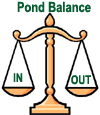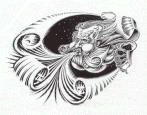|

|
|

|
|

|
There are many components of a backyard pond
but the basic elements boil down to water, fish and aquatic plants. Of
course, every pond must have water but the other two are not required
for everyone.
Fish add another wonderful dimension to a backyard pond. Watching
them glide effortlessly through the water is a soothing sight. They can
become pets and you will soon get to know each individual on
sight.
|
However, the addition of fish into the backyard pond adds to the
complexity of the ecosystem. Fish are living, growing, changing
organisms. They eat and breath and they discharge waste products into
your beautiful pond! Those waste products are nutrient rich and, if not
balanced out, they will contribute to the growth of algae in the pond.
In extreme cases, if the wastes build up, they can actually deprive the
fish of needed oxygen and kill them too.
When first
introducing fish to the pond, put the fish still inside their sealed bag
into the pond allowing 15 minutes for the temperature to equalize
between the bag and the pond before releasing the fish. If it is a sunny
day cover the bag to prevent overheating.
|
 How many fish are too many? How many fish are too many?
 Unfortunately, there is no single answer to this question. You see
some generalizations such as 1 inch of fish per 3 to 5 gallons of water.
According to this calculation, a 200 gallon pond (very small) could accommodate 4 ten inch long fish. By extrapolation, a 2000 gallon pond
(not huge) could have 40 ten inch fish. Of course, they would not be
able to move very much without bumping into each other! Unfortunately, there is no single answer to this question. You see
some generalizations such as 1 inch of fish per 3 to 5 gallons of water.
According to this calculation, a 200 gallon pond (very small) could accommodate 4 ten inch long fish. By extrapolation, a 2000 gallon pond
(not huge) could have 40 ten inch fish. Of course, they would not be
able to move very much without bumping into each other!
The lesson here is to beware of such generalizations. In determining
how many fish to have in your pond, consider the following factors:
|
 Filtration:
Since more and bigger fish are going to produce
larger volumes of waste, one factor of the carrying capacity of your
pond is the Filtration:
Since more and bigger fish are going to produce
larger volumes of waste, one factor of the carrying capacity of your
pond is the
 type of filtration you install. If you do not use any
filtration, the pond system must take care of the waste on its own.
Aquatic plants will use some of it but, in almost all cases, algae
will move in to use up the rest. Too many fish in this situation and
you will have pea soup before you know it. type of filtration you install. If you do not use any
filtration, the pond system must take care of the waste on its own.
Aquatic plants will use some of it but, in almost all cases, algae
will move in to use up the rest. Too many fish in this situation and
you will have pea soup before you know it.
Use of basic biofiltration as part of your water circulation system
will allow you to increase your fish population and avoid pea soup.
This generally includes some type of waterfall which will add to the
oxygen content of the water.
If you are really serious about the fish part of your pond, you
will install a much more elaborate filtration system. It will run the
water through several containers which will extract large quantities
of the nutrients and other chemical byproducts produced by the fish.
These systems can be expensive and require upkeep. However, if your
goal is to produce those huge, award winning koi, these more elaborate
systems are a must.
|
 Pond Depth:
You need to have at least 18 inches of water
to even think about keeping fish in a pond year around. Generally,
the deeper, the better. Pond Depth:
You need to have at least 18 inches of water
to even think about keeping fish in a pond year around. Generally,
the deeper, the better.
 Shallow water warms up quickly but it also
cools down quickly. Temperature change is one factor that leads to
fish stress and disease. Shallow water warms up quickly but it also
cools down quickly. Temperature change is one factor that leads to
fish stress and disease.
Deeper water moderates the changes in temperature. It is also
better for overwintering fish at the bottom of the pond. Deeper water
makes it harder for critters such as raccoons and herons from catching
the fish for a snack.
|
 Your Willpower:
As living creatures, fish know about the
birds and the bees just like other animals. Suddenly one spring,
your 4 ten inch fish are joined by 10 more one inch long fry. They
begin eating and start to add the inches. Then comes the dilemma. Your Willpower:
As living creatures, fish know about the
birds and the bees just like other animals. Suddenly one spring,
your 4 ten inch fish are joined by 10 more one inch long fry. They
begin eating and start to add the inches. Then comes the dilemma.
You already figured that your pond could only handle the equivalent
of 4 ten inch fish. Now you have 10 little guys who will soon be
bigger guys. What do you do?
If you just ignore them, before long, you will see an increase in
the algae in your pond. You will see more fish die over the winter.
You might also begin to see diseases rear their ugly heads.
So, you need to remove some of those fish. If you are lucky, you
will have friends who are just starting a pond and can use some free
fish. More likely, they already have more than they need too. What
then?
 DO NOT DUMP THE EXTRA FISH IN A POND OR STREAM IN A LOCAL
AREA
OR ANYWHERE ELSE!!!!!! Many of the fish we grow in ponds are not
native to the U.S. and their release will result in one of two things.
Either they will live and begin competing with local species or they
will die because they are not adapted to local conditions. DO NOT DUMP THE EXTRA FISH IN A POND OR STREAM IN A LOCAL
AREA
OR ANYWHERE ELSE!!!!!! Many of the fish we grow in ponds are not
native to the U.S. and their release will result in one of two things.
Either they will live and begin competing with local species or they
will die because they are not adapted to local conditions.
|
|



